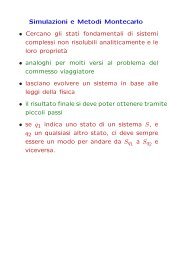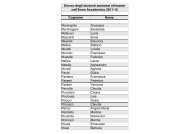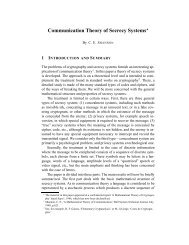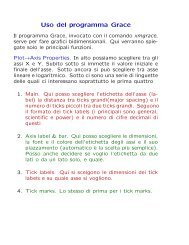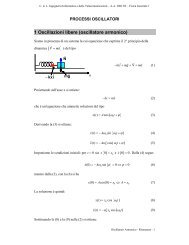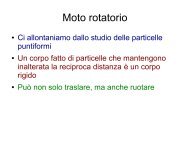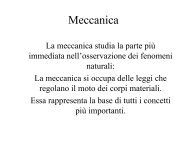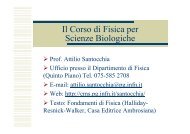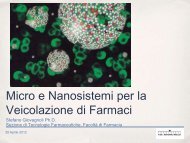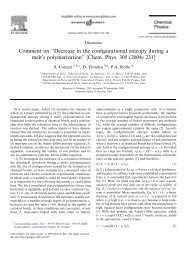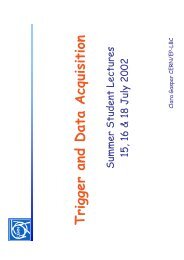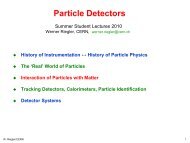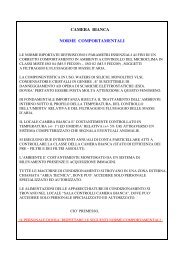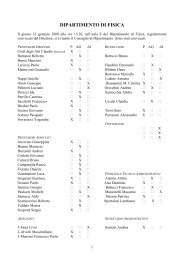Two crossover regions in the dynamics of glass forming ... - Fisica
Two crossover regions in the dynamics of glass forming ... - Fisica
Two crossover regions in the dynamics of glass forming ... - Fisica
Create successful ePaper yourself
Turn your PDF publications into a flip-book with our unique Google optimized e-Paper software.
J. Chem. Phys., Vol. 117, No. 5, 1 August 2002 <strong>Two</strong> <strong>crossover</strong> <strong>regions</strong> <strong>in</strong> <strong>the</strong> <strong>dynamics</strong> <strong>of</strong> epoxy res<strong>in</strong>s<br />
V. CONCLUSIONS<br />
The dynamic <strong>glass</strong> transition <strong>of</strong> PPGE and DGEBA has<br />
been studied by means <strong>of</strong> broadband dielectric spectroscopy,<br />
heat capacity spectroscopy 3 method, and viscosimetry.<br />
<strong>Two</strong> well-separated <strong>crossover</strong> <strong>regions</strong> <strong>crossover</strong> and <br />
<strong>crossover</strong> have been identified, around T c()(1.1<br />
1.2)T g , c()10 6 s, and T c()(1.41.5)T g ,<br />
c()10 10 s, respectively.<br />
The <strong>crossover</strong> is characterized by <strong>the</strong> onset <strong>of</strong> <strong>the</strong><br />
(a,) transition, with a relaxation time about one decade<br />
greater than that <strong>of</strong> <strong>the</strong> cont<strong>in</strong>uous trace <strong>of</strong> <strong>the</strong> (a,) processes,<br />
<strong>the</strong> a process be<strong>in</strong>g <strong>the</strong> high-temperature part <strong>of</strong> <strong>the</strong><br />
ma<strong>in</strong> dynamic transition. In <strong>the</strong> <strong>in</strong>termediate-temperature region,<br />
between <strong>the</strong> and <strong>crossover</strong>, <strong>the</strong> ma<strong>in</strong> transition<br />
seems to be characterized by a low cooperativity N 1, and<br />
it has been labeled a for analogies with <strong>the</strong> hightemperature<br />
a process. At lower temperatures, <strong>the</strong> <strong>crossover</strong><br />
is characterized by a cont<strong>in</strong>uous trace <strong>of</strong> <strong>the</strong> ma<strong>in</strong><br />
(a,) transition where <strong>the</strong> <strong>crossover</strong> region is identified by<br />
<strong>the</strong> extrapolation from lower temperatures <strong>of</strong> <strong>the</strong> relaxation<br />
time to <strong>the</strong> ma<strong>in</strong> relaxation time; a Stickel bend <strong>in</strong> <strong>the</strong> trace<br />
<strong>of</strong> <strong>the</strong> (a,) transition with a Vogel temperature T 0 for <strong>the</strong><br />
process which is smaller than that for <strong>the</strong> a process; and<br />
<strong>the</strong> separation <strong>of</strong> <strong>the</strong> <strong>in</strong>dividual temperature dependences <strong>of</strong><br />
different transport properties such as impurity-ion diffusion<br />
coefficient and viscosity breakdown <strong>of</strong> <strong>the</strong> Stokes–E<strong>in</strong>ste<strong>in</strong><br />
law. The comparison <strong>of</strong> dielectric relaxation times with configurational<br />
entropy data from calorimetry shows <strong>the</strong> validity<br />
<strong>of</strong> <strong>the</strong> Adam–Gibbs relation for <strong>the</strong> temperature dependence<br />
<strong>of</strong> <strong>the</strong> relaxation time at temperatures below <strong>the</strong><br />
-<strong>crossover</strong> region. 60 There, cooperativity starts to <strong>in</strong>crease<br />
significantly.<br />
Also <strong>the</strong> secondary relaxations show changes across <strong>the</strong><br />
<strong>glass</strong> transitions. A significant curvature and a lower<strong>in</strong>g <strong>of</strong><br />
<strong>the</strong> trace below <strong>the</strong> l<strong>in</strong>ear extrapolation from temperatures<br />
lower than T g can be clearly observed <strong>in</strong> <strong>the</strong> Arrhenius plot<br />
<strong>of</strong> both PPGE and DGEBA. These effects are not an artifact<br />
<strong>of</strong> <strong>the</strong> data evaluation s<strong>in</strong>ce is large enough and <strong>the</strong><br />
trace <strong>of</strong> <strong>the</strong> ma<strong>in</strong> transition <strong>in</strong> <strong>the</strong> Arrhenius plot is two or<br />
more frequency decades below <strong>the</strong> measured trace. Ano<strong>the</strong>r<br />
<strong>in</strong>terest<strong>in</strong>g feature shown by secondary processes is <strong>the</strong><br />
<strong>in</strong>fluence <strong>of</strong> freez<strong>in</strong>g-<strong>in</strong> on <strong>the</strong> amplitude <strong>of</strong> <strong>the</strong> relaxation<br />
(T), which shows a significant bend at T g . This suggests<br />
<strong>the</strong> existence <strong>of</strong> some <strong>in</strong>tr<strong>in</strong>sic relation between <strong>the</strong><br />
dynamic <strong>glass</strong> transition and secondary relaxations. Temperature<br />
effects on secondary relaxations promise to be important<br />
for a deeper understand<strong>in</strong>g <strong>of</strong> <strong>the</strong> <strong>glass</strong> transition<br />
phenomenon and are currently <strong>the</strong> subject <strong>of</strong> fur<strong>the</strong>r <strong>the</strong>oretical<br />
and experimental effort.<br />
ACKNOWLEDGEMENTS<br />
We thank P. A. Rolla and M. Lucchesi for helpful discussions,<br />
and acknowledge f<strong>in</strong>ancial support from MIUR-<br />
PRIN2000, <strong>the</strong> Deutsche Forschungsgeme<strong>in</strong>schaft DFG <strong>in</strong><br />
particular, S.C. acknowledges <strong>the</strong> SFB 418 support<strong>in</strong>g her<br />
stay <strong>in</strong> Halle and <strong>the</strong> Fonds Chemische Industrie FCI.<br />
2447<br />
1 M. Be<strong>in</strong>er, H. Huth, and K. Schröter, J. Non-Cryst. Solids 279, 126<br />
2001.<br />
2 K. L. Ngai, J. Non-Cryst. Solids 275, 72000.<br />
3 G. Williams, Trans. Faraday Soc. 62, 2091 1966.<br />
4 G. P. Johari and M. Goldste<strong>in</strong>, J. Chem. Phys. 53, 2372 1970.<br />
5 G. P. Johari and M. Goldste<strong>in</strong>, J. Chem. Phys. 55, 4245 1971.<br />
6 G. P. Johari and M. Goldste<strong>in</strong>, J. Chem. Phys. 74, 2034 1970.<br />
7 F. Garwe, A. Schönhals, H. Lockwenz, M. Be<strong>in</strong>er, K. Schröter, and E.<br />
Donth, Macromolecules 29, 247 1996.<br />
8 R. Casal<strong>in</strong>i, D. Fioretto, A. Livi, M. Lucchesi, and P. A. Rolla, Phys. Rev.<br />
B 56, 3016 1997.<br />
9 S. Kahle, J. Korus, E. Hempel, R. Unger, S. Hör<strong>in</strong>g, K. Schröter, and E.<br />
Donth, Macromolecules 30, 7214 1997.<br />
10 F. Stickel, PhD <strong>the</strong>sis, Universität Ma<strong>in</strong>z, Ma<strong>in</strong>z, Germany, 1995.<br />
11 F. Stickel, E. W. Fischer, and R. Richert, J. Chem. Phys. 102, 6251 1995.<br />
12 F. Stickel, E. W. Fischer, and R. Richert, J. Chem. Phys. 104, 2043 1996.<br />
13 C. Hansen, F. Stickel, R. Richert, and E. W. Fischer, J. Chem. Phys. 108,<br />
6408 1998.<br />
14 F. Fujara, B. Geil, H. Sillescu, and G. Fleischer, Z. Phys. B: Condens.<br />
Matter 88, 195 1992.<br />
15 J. H. Magill and D. J. Plazek, J. Chem. Phys. 46, 3757 1967.<br />
16 K. L. Ngai, J. H. Magill, and D. J. Plazek, J. Chem. Phys. 112, 1887<br />
2000.<br />
17 E. Rössler, Phys. Rev. Lett. 65, 1595 1990.<br />
18 G. Adam and J. H. Gibbs, J. Chem. Phys. 43, 1391965.<br />
19 R. Richert and C. A. Angell, J. Chem. Phys. 108, 9016 1998.<br />
20 K. Ngai, Phys. Rev. E 57, 7346 1998.<br />
21 K. L. Ngai, J. Chem. Phys. 111, 3639 1999.<br />
22 M. Be<strong>in</strong>er, S. Kahle, E. Hempel, K. Schröter, and E. Donth, Europhys.<br />
Lett. 44, 321 1998.<br />
23 S. Kahle, K. Schröter, E. Hempel, and E. Donth, J. Chem. Phys. 111, 6462<br />
1999.<br />
24 E. Donth, The Glass Transition. Relaxation Dynamics <strong>in</strong> Liquids and Disordered<br />
Materials Spr<strong>in</strong>ger, Berl<strong>in</strong> 2001.<br />
25 S. S. N. Murthy, J. Chem. Soc., Faraday Trans. 2 85, 5811989.<br />
26 S. S. N. Murthy, J. Mol. Liq. 44, 511989.<br />
27 A. Schönhals, <strong>in</strong> Non Equilibrium Phenomena <strong>in</strong> Supercooled Fluids,<br />
Glasses and Amorphous Materials, edited by M. Giordano, D. Lepor<strong>in</strong>i,<br />
and M. Tosi World Scientific, S<strong>in</strong>gapore 1996, p.210.<br />
28 E. Donth, H. Huth, and M. Be<strong>in</strong>er, J. Phys.: Condens. Matter 13, L451<br />
2001.<br />
29 S. Corezzi, S. Capaccioli, R. Casal<strong>in</strong>i, D. Fioretto, M. Paluch, and P. A.<br />
Rolla, Chem. Phys. Lett. 320, 1132000.<br />
30 W. H. Press, S. A. Teukolsky, W. T. Vetterl<strong>in</strong>g, and B. P. Flannery, Numerical<br />
Recipes Cambridge University Press, Cambridge, 1992.<br />
31 N. O. Birge and S. R. Nagel, Phys. Rev. Lett. 54, 2674 1985.<br />
32 J. Korus, M. Be<strong>in</strong>er, K. Busse, S. Kahle, R. Unger, and E. Donth, Thermochim.<br />
Acta 304Õ305, 991997.<br />
33 H. Huth, M. Be<strong>in</strong>er, S. Weyer, M. Merzlyakov, C. Schick, and E. Donth,<br />
Thermochim. Acta 377, 1132001.<br />
34 H. Huth, M. Be<strong>in</strong>er, and E. Donth, Phys. Rev. B 61, 15092 2000.<br />
35 K. Schröter and E. Donth, J. Chem. Phys. 113, 9101 2000.<br />
36 L. Comez, D. Fioretto, L. Palmieri et al., Phys. Rev. E 60, 3086 1999.<br />
37 M. Be<strong>in</strong>er, J. Korus, H. Lockwenz, K. Schröter, and E. Donth, Macromol-<br />
ecules 29, 5183 1996.<br />
38 P. K. Dixon and S. R. Nagel, Phys. Rev. Lett. 61, 3411988.<br />
39 P. K. Dixon, Phys. Rev. B 42, 8179 1990.<br />
40 W. Götze and L. Sjögren, Rep. Prog. Phys. 55, 2411992.<br />
41 F. Alvarez, A. H<strong>of</strong>fman, A. Alegría, and J. Colmenero, J. Chem. Phys.<br />
105, 432 1996.<br />
42 A. Arbe, D. Richter, J. Colmenero, and B. Farago, Phys. Rev. E 54, 3853<br />
1996.<br />
43 K. Schröter, R. Unger, S. Reissig, F. Garwe, S. Kahle, M. Be<strong>in</strong>er, and E.<br />
Donth, Macromolecules 31, 8966 1998.<br />
44 R. Bergman, F. Alvarez, A. Alegría, and J. Colmenero, J. Chem. Phys.<br />
109, 7546 1998.<br />
45 E. Donth, K. Schröter, and S. Kahle, Phys. Rev. E 60, 1099 1999.<br />
46 A. Arbe, J. Colmenero, D. Gómez, D. Richter, and B. Farago, Phys. Rev.<br />
E 60, 11031999.<br />
47 A. Kudlik, S. Benkh<strong>of</strong>, T. Blochowicz, C. Tschirwitz, and E. Rössler, J.<br />
Mol. Struct. 479, 201 1999.<br />
48 A. Justl, Degree <strong>the</strong>sis, Universität Bayreuth, Bayreuth, Germany, 2000.<br />
49 S. Capaccioli unpublished.<br />
50 S. Corezzi, E. Campani, P. A. Rolla, S. Capaccioli, and D. Fioretto, J.<br />
Downloaded 14 Nov 2002 to 194.95.63.241. Redistribution subject to AIP license or copyright, see http://ojps.aip.org/jcpo/jcpcr.jsp



